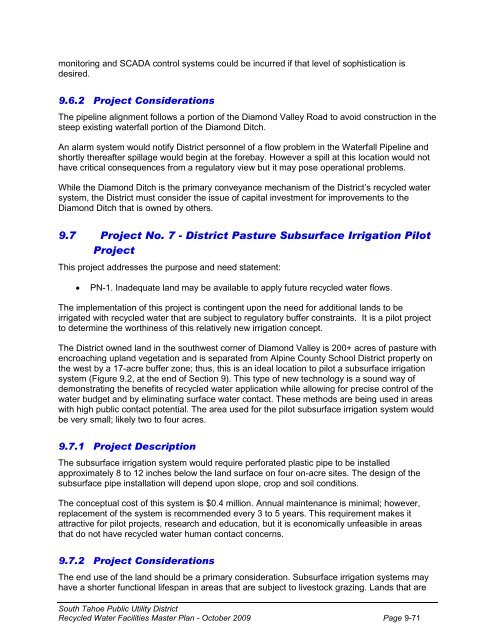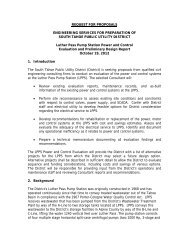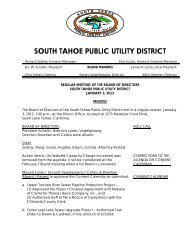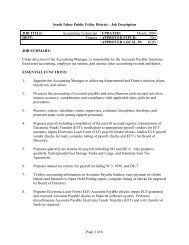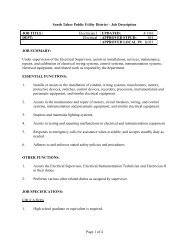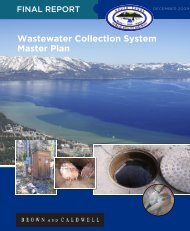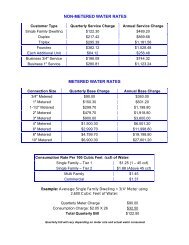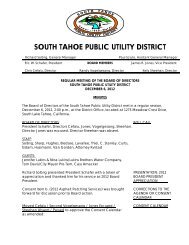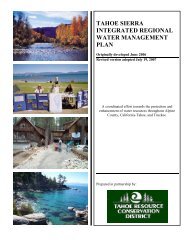October 2009 - South Tahoe Public Utility District
October 2009 - South Tahoe Public Utility District
October 2009 - South Tahoe Public Utility District
Create successful ePaper yourself
Turn your PDF publications into a flip-book with our unique Google optimized e-Paper software.
monitoring and SCADA control systems could be incurred if that level of sophistication is<br />
desired.<br />
9.6.2 Project Considerations<br />
The pipeline alignment follows a portion of the Diamond Valley Road to avoid construction in the<br />
steep existing waterfall portion of the Diamond Ditch.<br />
An alarm system would notify <strong>District</strong> personnel of a flow problem in the Waterfall Pipeline and<br />
shortly thereafter spillage would begin at the forebay. However a spill at this location would not<br />
have critical consequences from a regulatory view but it may pose operational problems.<br />
While the Diamond Ditch is the primary conveyance mechanism of the <strong>District</strong>‟s recycled water<br />
system, the <strong>District</strong> must consider the issue of capital investment for improvements to the<br />
Diamond Ditch that is owned by others.<br />
9.7 Project No. 7 - <strong>District</strong> Pasture Subsurface Irrigation Pilot<br />
Project<br />
This project addresses the purpose and need statement:<br />
<br />
PN-1. Inadequate land may be available to apply future recycled water flows.<br />
The implementation of this project is contingent upon the need for additional lands to be<br />
irrigated with recycled water that are subject to regulatory buffer constraints. It is a pilot project<br />
to determine the worthiness of this relatively new irrigation concept.<br />
The <strong>District</strong> owned land in the southwest corner of Diamond Valley is 200+ acres of pasture with<br />
encroaching upland vegetation and is separated from Alpine County School <strong>District</strong> property on<br />
the west by a 17-acre buffer zone; thus, this is an ideal location to pilot a subsurface irrigation<br />
system (Figure 9.2, at the end of Section 9). This type of new technology is a sound way of<br />
demonstrating the benefits of recycled water application while allowing for precise control of the<br />
water budget and by eliminating surface water contact. These methods are being used in areas<br />
with high public contact potential. The area used for the pilot subsurface irrigation system would<br />
be very small; likely two to four acres.<br />
9.7.1 Project Description<br />
The subsurface irrigation system would require perforated plastic pipe to be installed<br />
approximately 8 to 12 inches below the land surface on four on-acre sites. The design of the<br />
subsurface pipe installation will depend upon slope, crop and soil conditions.<br />
The conceptual cost of this system is $0.4 million. Annual maintenance is minimal; however,<br />
replacement of the system is recommended every 3 to 5 years. This requirement makes it<br />
attractive for pilot projects, research and education, but it is economically unfeasible in areas<br />
that do not have recycled water human contact concerns.<br />
9.7.2 Project Considerations<br />
The end use of the land should be a primary consideration. Subsurface irrigation systems may<br />
have a shorter functional lifespan in areas that are subject to livestock grazing. Lands that are<br />
<strong>South</strong> <strong>Tahoe</strong> <strong>Public</strong> <strong>Utility</strong> <strong>District</strong><br />
Recycled Water Facilities Master Plan - <strong>October</strong> <strong>2009</strong> Page 9-71


